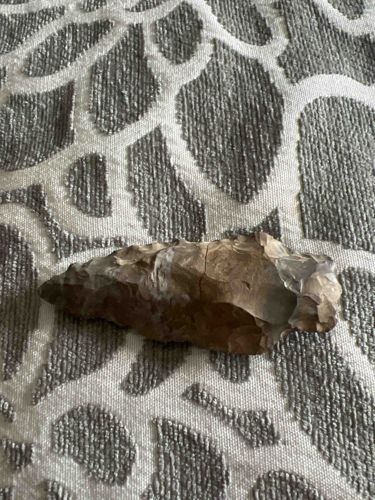
Prehistoric Chert Projectile Point
This item is an ancient projectile point, commonly referred to as an 'Indian arrowhead,' crafted from a type of chert or flint. Its physical characteristics reveal a lithic reduction process, exhibiting conchoidal fractures indicative of knapping. The material presents a mottled appearance with shades of light brown, grey, and hints of a translucent or glassy quality, especially towards the tip and one of the edges, suggesting a high-quality chert. The size appears to be approximately 2 to 3 inches in length based on the background textile pattern which suggests a common household fabric. The construction is bifacial, meaning both sides have been flaked to create sharp edges. Notable features include distinct flake scars that are characteristic of pressure or percussion flaking techniques. The overall shape is tapering to a point, though the base is not clearly visible in these images. There are visible condition issues; specifically, a significant break or large chip is present on one side, near what would be the widest part of the blade, which impacts its structural integrity and historical completeness. This damage appears to be an ancient fracture, showing no signs of recent, fresh breaks. The surfaces show a natural patina, suggesting prolonged exposure to environmental conditions. Given the craftsmanship and material, it is likely prehistoric, dating from various periods depending on the specific typology, which is not fully discernible from the provided images due to the angle and partial visibility. The quality of craftsmanship, despite the damage, suggests a skilled knapper created this tool, with relatively uniform flaking along the remaining edges.
AI-Generated Appraisal Disclaimer
Estimated Value
$40-80
Basic Information
Category
Archaeological Artifact
Appraised On
December 2, 2025
Estimated Value
$40-80
Additional Details Provided By Owner
User Provided Information
Indian arrowhead
Item Description
This item is an ancient projectile point, commonly referred to as an 'Indian arrowhead,' crafted from a type of chert or flint. Its physical characteristics reveal a lithic reduction process, exhibiting conchoidal fractures indicative of knapping. The material presents a mottled appearance with shades of light brown, grey, and hints of a translucent or glassy quality, especially towards the tip and one of the edges, suggesting a high-quality chert. The size appears to be approximately 2 to 3 inches in length based on the background textile pattern which suggests a common household fabric. The construction is bifacial, meaning both sides have been flaked to create sharp edges. Notable features include distinct flake scars that are characteristic of pressure or percussion flaking techniques. The overall shape is tapering to a point, though the base is not clearly visible in these images. There are visible condition issues; specifically, a significant break or large chip is present on one side, near what would be the widest part of the blade, which impacts its structural integrity and historical completeness. This damage appears to be an ancient fracture, showing no signs of recent, fresh breaks. The surfaces show a natural patina, suggesting prolonged exposure to environmental conditions. Given the craftsmanship and material, it is likely prehistoric, dating from various periods depending on the specific typology, which is not fully discernible from the provided images due to the angle and partial visibility. The quality of craftsmanship, despite the damage, suggests a skilled knapper created this tool, with relatively uniform flaking along the remaining edges.
Get Your Items Appraised
Instant estimates of your treasures with AI-powered instant appraisals